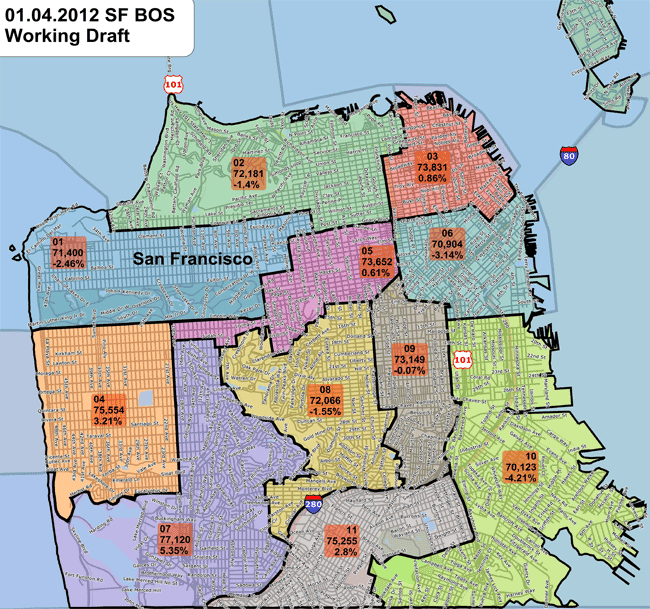City task force proposes changes to District 2 boundaries
February 2012

With elections approaching, the issue of political “redistricting” is buzzing in the air, as it may have an impact on elections at national, state and local levels. As part of our national political process, electoral district map boundaries are redrawn every 10 years based upon U.S. Census Bureau data. As Loyola Law School professor Justin Levitt described it for the Huffington Post, 428 U.S. Congressional districts in 43 states must be redrawn (seven states have just one representative each), while 7,382 state legislative districts and hundreds of thousands of local districts must also be adjusted. Law prescribes the complex process involved in redrawing those district lines.
But adjusting voter districts is not as negative as some might think, according to Paul Mitchell of Redistricting Partners, a firm in Sacramento that specializes in helping cities, counties, school districts, and other civic entities manage the complicated task of adjusting, remapping, and in some cases creating new districts.
“Redistricting is a necessary thing because districts outgrow themselves,” said Mitchell.
Talking with the Marina Times, he noted that even a utopian society has to deal with population changes and shifts.Mitchell pointed out that redistricting is a way to ensure fair and equal representation of the various groups and social demographics within a society. This applies even in the case of special interest groups, to dispel and avoid the forming of a “provincial culture,” as he explained. Each group within a given society must be heard and represented fairly and, according to Mitchell, redistricting has been a way to do that. “It is actually about empowering people,” said Mitchell. “Districts must be equal in proportion so that no one group or social demographic is excluded from the political and electoral process.”
Mitchell mentioned also that redistricting is done in many different ways nationwide. The U.S. Congress, U.S. Senate, and state and local legislatures all have their own procedures; it must be done properly and should be carried out with as much transparency as possible.
San Francisco has a Redistricting Task Force consisting of nine appointed members to address the remapping of the City’s 11 supervisorial districts. The City Charter does provide for the Director of Elections to examine whether existing districts “continue to meet the requirements of federal and state law and the criteria for drawing districts lines set in the Charter.”
What that means, said press secretary Matt Dorsey speaking on behalf of City Attorney Dennis Herrera, is “it’s theoretically possible that if [a district’s census numbers] don’t change, there won’t be a need for redistricting.” “Keep in mind, however, that even if one district remains demographically unchanged, it may still have to undergo redistricting because of changes required to adjacent districts,” said Dorsey. “Given the size, development and demographic trends in a city like San Francisco, it’s almost inconceivable that redistricting wouldn’t occur.”
District 2 Remapping Will Be Discussed at Public Meeting on Feb. 6
Fifteen community meetings have been scheduled this year by the Redistricting Task Force (RDTF) to discuss and gather public input on proposed boundary changes. “The Redistricting Task Force formulated its first draft map at the Jan. 4, 2012 meeting,” said Andrew Shen, deputy city attorney in Herrera’s office. He noted that the draft maps, meeting schedules, and lots of other relevant information are available online at www.sfgov.org/rdtf.
A District 2 community outreach meeting will be held on Monday, Feb. 6 at 6 p.m., set tentatively at Marina Middle School (3500 Fillmore Street at Chestnut). Shen said that people should check the RDTF website ahead of time for confirmation of the time and location.
“The public can also share their thoughts after that date as well,” said Shen. “They can do it at [another] meeting or they can e-mail the Redistricting Task Force at [email protected].”
S.F. voters, like everyone else, should simply consider redistricting every decade as part of the electoral routine and not be alarmed. Even if groups along political party lines express concern and seek litigation, this is all part of the process and routine. “Lawsuits are inevitable,” said redistricting consultant Mitchell, as he pointed to comments made by Professor Levitt in his Huffington Post article posted on Jan. 3, 2012: “Redistricting litigation joins death and taxes as one of life’s certainties.”
“No doubt partisan groups will try to influence redistricting,” said San Francisco District 2 Supervisor Mark Farrell (no relation to this reporter). Yet Supervisor Farrell also said that, with regard to all redistricting efforts (committees, task force groups, etc.), “They must follow the legal guidelines. They have to do a lot of things legally hard and fast.”
What actual impact will San Francisco redistricting have? It is still too early to say.
“That we will have to wait and see as it unfolds in April,” Farrell said. If the newly drawn boundary lines place Farrell outside of District 2, he is not worried. City Charter allows current-serving city supervisors to complete their term, even if their residence is placed outside the district they serve due to redistricting. Farrell’s term ends in 2014, yet he assured us that if his residence is placed outside the district lines for District 2 by remapping, he remains committed to his constituency.
“I live in District 2 and grew up in District 2; if the new lines place me outside of it, I will move, absolutely. District 2 always has been and will be my home,” Farrell said.


